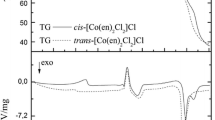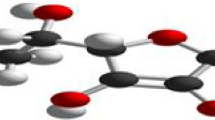Abstract
Enthalpies of dissolution of acetonitrile, propylene carbonate, and 1,4-dioxane in mixtures of water with acetone or DMSO were measured in the whole concentration range of the mixed solvents. Standard enthalpies of dissolution and enthalpies of transfer of solutes from water to its mixtures with acetone or DMSO were determined. In the region of small proportions of the nonaqueous component, the enthalpy of cavity formation in the mixed solvent makes the main contribution to the variation of the enthalpy of dissolution. An increase in the proportion of the nonaqueous component leads to competition between the contributions of cavity formation and specific interaction between the solute and the solvent during solvation.
Similar content being viewed by others
References
A. C. Rouw and G. Somsen,J. Solut. Chem., 1981,10, 533.
A. C. Rouw and G. Somsen,J. Chem. Soc., Faraday Trans. 1, 1982,78, 3397.
Yu. M. Kessler and A. L. Zaitsev,Sol'vofobnye effekty [Solvophobic Effects], Khimiya, Leningrad, 1989, (in Russian).
V. P. Korolev, D. V. Batov, V. N. Vandyshev, and O. A. Antonova,Termodinamika rastvorov neelektrolitov [Thermodynamics of Solutions of Nonelectrolytes], 1989,1, 13 (in Russian).
B. G. Cox,J. Chem. Soc., Perkin Trans. 2, 1973, 607.
A. Gordon and R. Ford,The Chemist's Companion. A Handbook of Practical Data, Techniques, and References, J. Wiley & Sons, New York—London, 1972.
A. Weissberger, E. Proskauer, and D. Riddick,Organic Solvents, Physical Properties and Methods of Purification, Ed. A. Weissberger, Interscience Publishers, New York, 1955.
D. V. Batov, Ph.D. (Chem.) Thesis, Institute of Chemistry of Non-Aqueous Solutions of the USSR Academy of Sciences, Ivanovo, 1987 (in Russian).
V. P. Belousov and M. Yu. Panov,Termodinamika vodnykh rastvorov neelektrolitov [Thermodynamics of Aqueous Solutions of Nonelectrolytes], Khimiya, Leningrad, 1983 (in Russian).
M. I. Shakhparonov and I. V. Chekalin,Zh. Strukt. Khim., 1970,11, 599 [J. Struct. Chem. USSR, 1970,11 (Engl. Transl.)].
C. M. Kinart, W. J. Kinart, and L. Skulski,Pol. J. Chem., 1986,41, 4519.
U. Mayer, W. Gerger, and V. Gutmann,Monatsh. Chem., 1977,108, 489.
T. M. Krygowski, P. K. Wrona, and U. Zielkowska,Tetrahedron, 1985,41, 4519.
V. Gutmann,Coordination Chemistry in Non-Aqueuos Solutions, Ed. V. Gutmann, Springer Verlag, Vienna—New York, 1968.
A. Bondy,J. Phys. Chem., 1964,63, 441.
Author information
Authors and Affiliations
Additional information
Translated fromIzvestiya Akademii Nauk. Seriya Khimicheskaya, No. 9, pp. 1747–1752, September, 1995.
Rights and permissions
About this article
Cite this article
Kulikov, M.V., Antonova, O.A., Slyusar, V.P. et al. Enthalpies of dissolution of propylene carbonate, acetonitrile, and 1,4-dioxane in mixtures of water with acetone or dimethyl sulfoxide. Russ Chem Bull 44, 1678–1683 (1995). https://doi.org/10.1007/BF01151290
Received:
Revised:
Issue Date:
DOI: https://doi.org/10.1007/BF01151290




